What’s Love Got to do with it?
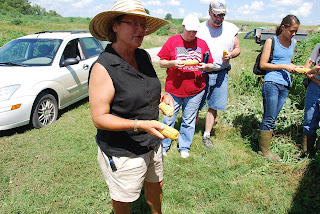 On Sunday, August 1 at the farm of Laura Krouse near Mt. Vernon in east central Iowa farmers and eaters learned the importance of pollination. Laura and USDA corn breeders Linda Pollak and John Golden taught attendees different methods of improving, selecting and storing corn seed.
On Sunday, August 1 at the farm of Laura Krouse near Mt. Vernon in east central Iowa farmers and eaters learned the importance of pollination. Laura and USDA corn breeders Linda Pollak and John Golden taught attendees different methods of improving, selecting and storing corn seed. Laura developed and markets Abbe Hills Open Pollinated corn. She using equipment that was on the farm to be able to shell, sort or screen, store and bag the corn. The base genetics of this
Laura developed and markets Abbe Hills Open Pollinated corn. She using equipment that was on the farm to be able to shell, sort or screen, store and bag the corn. The base genetics of this
corn has been grown and selected on her farm since 1903. Laura began improving it over a decade ago.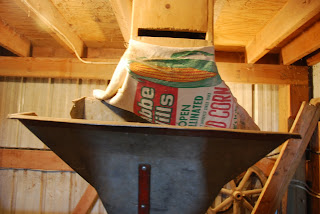
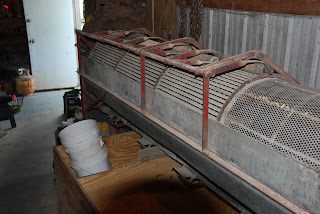 Laura has learned how to improve her breeding and selection techniques from Iowa State University breeders and USDA breeder Linda Pollak.
Laura has learned how to improve her breeding and selection techniques from Iowa State University breeders and USDA breeder Linda Pollak. Linda worked with Laura to add a southern South American corn to her Abbe Hills corn to improve its standability.
Linda worked with Laura to add a southern South American corn to her Abbe Hills corn to improve its standability.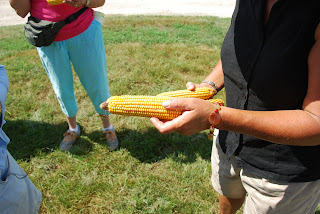 Laura’s customers noticed this change in growing her corn within a year of making the cross.
Laura’s customers noticed this change in growing her corn within a year of making the cross.
Laura also selects ears for making selections based on appearance. Although most breeders go into their fields throughout the summer to assess which plants stand the best, have the most corn, perhaps have larger leaf area, stronger roots or the ability to withstand variable weather in addition Laura has selected corn based on how the individual kernals appear.
Although most breeders go into their fields throughout the summer to assess which plants stand the best, have the most corn, perhaps have larger leaf area, stronger roots or the ability to withstand variable weather in addition Laura has selected corn based on how the individual kernals appear.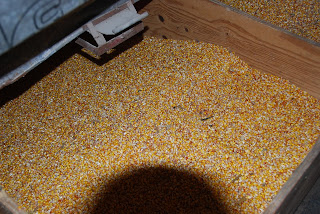 Laura likes the straight rows of corn with little dent.
Laura likes the straight rows of corn with little dent.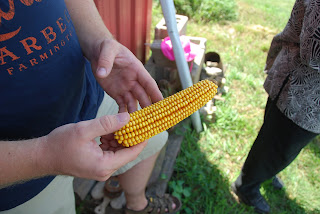 Linda Pollak and John Golden also spoke about how to make a hybrid on your farm. Some farmers are interested in producing seed and selling it or saving it for their farms. If you work with public varieties available through the USDA or Land Grant universities inbred lines can be developed and improved to increase their yields.
Linda Pollak and John Golden also spoke about how to make a hybrid on your farm. Some farmers are interested in producing seed and selling it or saving it for their farms. If you work with public varieties available through the USDA or Land Grant universities inbred lines can be developed and improved to increase their yields. Following the Corn Improvement workshop eaters and farmers took a beautiful, yet HOT, tour of Laura’s farm.
Following the Corn Improvement workshop eaters and farmers took a beautiful, yet HOT, tour of Laura’s farm.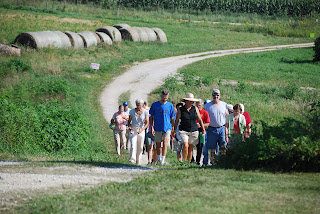
 Laura’s farm is 72 A including a large CSA for 200 families. She erected a hoop house last year at PFI’s Hoop House raising. Check out the video of the hoop house bu
Laura’s farm is 72 A including a large CSA for 200 families. She erected a hoop house last year at PFI’s Hoop House raising. Check out the video of the hoop house bu
ilding on the PFI website.
Laura raises a variety of fruits and vegetables for her consumers.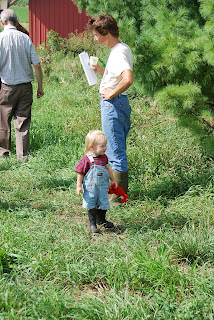 Like most diversified farmers good use of cover crops, crop rotation and biological methods are employed to control weeds and pests and provide natural forms of nutrients to the crop.
Like most diversified farmers good use of cover crops, crop rotation and biological methods are employed to control weeds and pests and provide natural forms of nutrients to the crop.  This year she has had excess colorado potato beetle outbreaks on her eggplants and lost a large amount of the crop. This was one of the first times Laura needed to use non-organic methods to control that pest. If she didn’t use a chemical to spray the beetles they would become a long-term pest on the rest of her farm. She discussed the decision-making process she followed to determine what chemical versus organic management was available. After trying several methods she used chemicals to kill the pest. She said she employs organic methods on everything else 99% of the time. But in this case without control of this pest this year it could become a bigger problem in the future.
This year she has had excess colorado potato beetle outbreaks on her eggplants and lost a large amount of the crop. This was one of the first times Laura needed to use non-organic methods to control that pest. If she didn’t use a chemical to spray the beetles they would become a long-term pest on the rest of her farm. She discussed the decision-making process she followed to determine what chemical versus organic management was available. After trying several methods she used chemicals to kill the pest. She said she employs organic methods on everything else 99% of the time. But in this case without control of this pest this year it could become a bigger problem in the future.
